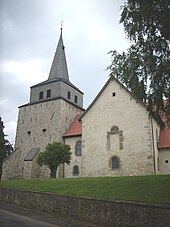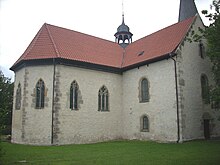St. Martin (Lühnde)
The Protestant Church of St. Martin in Lühnde , municipality of Algermissen , is the oldest church in the large open air .
Already around 800 a mission station with a chapel was built on today's church hill. The missionaries who came on behalf of Charlemagne probably chose a place where the Saxon population had previously worshiped their gods. It is possible that Franconians settled in this area at the same time .
The church was placed under the patronage of St. Martin. Martin of Tours was considered the patron saint of the Franconian Empire and his coat as its most precious relic (see chapel ). Perhaps at that time a tiny piece of Martin's coat came to Lühnde in order to bind the place and region to the new empire and its faith after the end of the Saxon Wars .
After the turn of the millennium, more and more villages of the Great Free got their own churches with their own parish rights. St. Martin remained archdeaconate , d. H. Center and baptistery.
The presumably small church that existed at that time was demolished before 1200 except for the defense tower and replaced by the original form of the current building.
This church was a Romanesque basilica on the plan of a Greek cross . The nave, east built onto the existing massive tower, consisted only of a square nave yoke with narrow zweijochigen aisles. The transept arms, the crossing and the choir had the same square floor plan . The apse with the main altar was connected to this in the east . There were two side apses in the east walls of the transept arms.
This Romanesque building was modernized in the following centuries, but also reduced in size. The vaults were partially renewed and provided with Gothic ribs. The choir received Gothic windows and the round main apse was replaced by an octagonal closure. However, these modernizations did not go beyond a minimum. At the same time, the church was reduced in size by demolishing the side aisles of the nave and the side apse. The late medieval changes reflect the then dwindling ecclesiastical and political importance of Lühndes. St. Martin's Church has been preserved to this day in the "slimmed down" form, with traces of the interventions still visible in some cases.
After the Hildesheim collegiate feud , Lühnde belonged to the Principality of Calenberg (while Algermissen remained with the small monastery ) and became Protestant around 1540 during the Reformation . In 1884 St. Martin was restored under the direction of Conrad Wilhelm Hase and received a neo-Gothic interior that is still there today.
Web links
Coordinates: 52 ° 16 ′ 20 ″ N , 9 ° 57 ′ 4 ″ E


